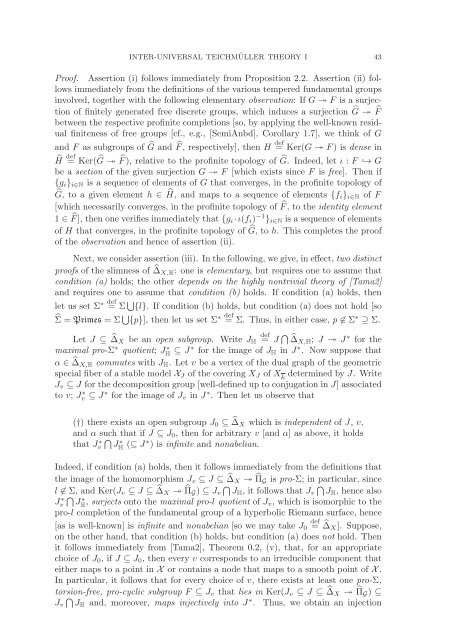Inter-universal Teichmuller Theory I: Construction of Hodge Theaters
Inter-universal Teichmuller Theory I: Construction of Hodge Theaters
Inter-universal Teichmuller Theory I: Construction of Hodge Theaters
You also want an ePaper? Increase the reach of your titles
YUMPU automatically turns print PDFs into web optimized ePapers that Google loves.
INTER-UNIVERSAL TEICHMÜLLER THEORY I 43<br />
Pro<strong>of</strong>. Assertion (i) follows immediately from Proposition 2.2. Assertion (ii) follows<br />
immediately from the definitions <strong>of</strong> the various tempered fundamental groups<br />
involved, together with the following elementary observation: IfG ↠ F is a surjection<br />
<strong>of</strong> finitely generated free discrete groups, which induces a surjection Ĝ ↠ ̂F<br />
between the respective pr<strong>of</strong>inite completions [so, by applying the well-known residual<br />
finiteness <strong>of</strong> free groups [cf., e.g., [SemiAnbd], Corollary 1.7], we think <strong>of</strong> G<br />
and F as subgroups <strong>of</strong> Ĝ and ̂F , respectively], then H def<br />
=Ker(G ↠ F )isdense in<br />
=Ker(Ĝ ↠ ̂F ), relative to the pr<strong>of</strong>inite topology <strong>of</strong> Ĝ. Indeed, let ι : F↩→ G<br />
be a section <strong>of</strong> the given surjection G ↠ F [which exists since F is free]. Then if<br />
{g i } i∈N is a sequence <strong>of</strong> elements <strong>of</strong> G that converges, in the pr<strong>of</strong>inite topology <strong>of</strong><br />
Ĝ, to a given element h ∈ Ĥ, and maps to a sequence <strong>of</strong> elements {f i} i∈N <strong>of</strong> F<br />
[which necessarily converges, in the pr<strong>of</strong>inite topology <strong>of</strong> ̂F ,totheidentity element<br />
1 ∈ ̂F ], then one verifies immediately that {g i ·ι(f i ) −1 } i∈N is a sequence <strong>of</strong> elements<br />
<strong>of</strong> H that converges, in the pr<strong>of</strong>inite topology <strong>of</strong> Ĝ, toh. This completes the pro<strong>of</strong><br />
<strong>of</strong> the observation and hence <strong>of</strong> assertion (ii).<br />
Ĥ def<br />
Next, we consider assertion (iii). In the following, we give, in effect, two distinct<br />
pro<strong>of</strong>s <strong>of</strong> the slimness <strong>of</strong> ̂Δ X,H :oneiselementary, but requires one to assume that<br />
condition (a) holds; the other depends on the highly nontrivial theory <strong>of</strong> [Tama2]<br />
and requires one to assume that condition (b) holds. If condition (a) holds, then<br />
let us set Σ ∗ def<br />
=Σ ⋃ {l}. If condition (b) holds, but condition (a) does not hold [so<br />
̂Σ =Primes =Σ ⋃ {p}], then let us set Σ ∗ def<br />
= Σ. Thus, in either case, p ∉ Σ ∗ ⊇ Σ.<br />
Let J ⊆ ̂Δ X be an open subgroup. Write J H<br />
def<br />
= J ⋂ ̂ΔX,H ; J ↠ J ∗ for the<br />
maximal pro-Σ ∗ quotient; J ∗ H ⊆ J ∗ for the image <strong>of</strong> J H in J ∗ . Now suppose that<br />
α ∈ ̂Δ X,H commutes with J H .Letv be a vertex <strong>of</strong> the dual graph <strong>of</strong> the geometric<br />
special fiber <strong>of</strong> a stable model X J <strong>of</strong> the covering X J <strong>of</strong> X k<br />
determined by J. Write<br />
J v ⊆ J for the decomposition group [well-defined up to conjugation in J] associated<br />
to v; J ∗ v ⊆ J ∗ for the image <strong>of</strong> J v in J ∗ . Then let us observe that<br />
(†) there exists an open subgroup J 0 ⊆ ̂Δ X which is independent <strong>of</strong> J, v,<br />
and α such that if J ⊆ J 0 , then for arbitrary v [and α] asabove,itholds<br />
that J ∗ v<br />
⋂ J<br />
∗<br />
H (⊆ J ∗ )isinfinite and nonabelian.<br />
Indeed, if condition (a) holds, then it follows immediately from the definitions that<br />
the image <strong>of</strong> the homomorphism J v ⊆ J ⊆ ̂Δ X ↠ ̂Π G is pro-Σ; in particular, since<br />
l ∉ Σ, and Ker(J v ⊆ J ⊆ ̂Δ X ↠ ̂Π G ) ⊆ J v<br />
⋂<br />
JH , it follows that J v<br />
⋂<br />
JH , hence also<br />
J ∗ v<br />
⋂ J<br />
∗<br />
H , surjects onto the maximal pro-l quotient <strong>of</strong> J v , which is isomorphic to the<br />
pro-l completion <strong>of</strong> the fundamental group <strong>of</strong> a hyperbolic Riemann surface, hence<br />
[as is well-known] is infinite and nonabelian [so we may take J 0<br />
def<br />
= ̂Δ X ]. Suppose,<br />
on the other hand, that condition (b) holds, but condition (a) does not hold. Then<br />
it follows immediately from [Tama2], Theorem 0.2, (v), that, for an appropriate<br />
choice <strong>of</strong> J 0 ,ifJ ⊆ J 0 ,theneveryv corresponds to an irreducible component that<br />
either maps to a point in X or contains a node that maps to a smooth point <strong>of</strong> X .<br />
In particular, it follows that for every choice <strong>of</strong> v, there exists at least one pro-Σ,<br />
torsion-free,<br />
⋂<br />
pro-cyclic subgroup F ⊆ J v that lies in Ker(J v ⊆ J ⊆ ̂Δ X ↠ ̂Π G ) ⊆<br />
J v JH and, moreover, maps injectively into J ∗ . Thus, we obtain an injection
















